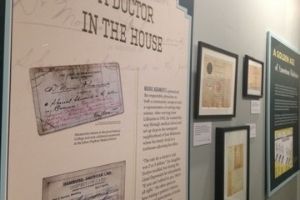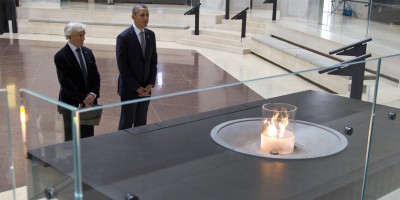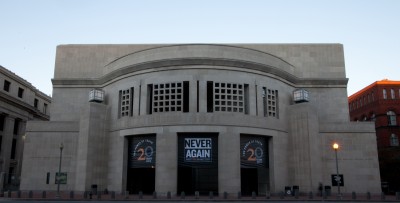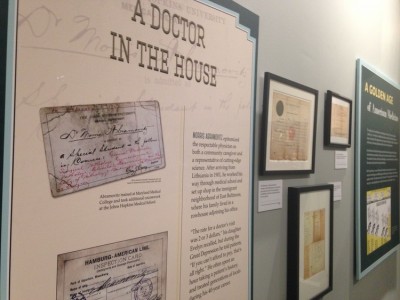Intern Thoughts: A Weekly Response

Every week we’re asking our summer interns to share some thoughts and responses to various experiences and readings. This week we asked interns to respond to Edward Rothstein’s article The Problem with Jewish Museums, which we asked them to originally read and discuss during their orientation back in June. This week they need to reflect back as well as read a number of responses to that article before articulating their own.
Would the Refugees Agree with Rothstein?
The author of “The Problem with Jewish Museums,” Rothstein, has clearly visited and dissected more Jewish and Holocaust museums than I. Some of his critiques, such as Jewish museums emphasizing Jews who succeeded based on American ideals rather than Jewish ones, are likely true. However, some of his observations, even if true, I don’t view in a negative light. As one response noted, thousands of Jewish museums exist around the world, and hundreds in America. They can’t, and shouldn’t, all emphasis the same points and ideas. Rothstein criticizes both Jewish museums that function as a “Jewish morgue” by emphasizing artifacts and supposedly ignoring continuity, as well as museums that focus too much on “universalizing” the Jewish experience and providing warnings about the future. Perhaps if he believes Jewish museums only focus on one or another, I understand the critique. However, what’s the problem with some museums focusing on the Jewish past without focusing on the present? What’s wrong with the Tolerance Museum, which doesn’t call itself the “genocide” museum, focusing on exactly what it’s focused on, intolerance of all kinds and degrees?
To his point about Holocaust Museums relating the Holocaust to other genocides, he includes the line “hey, you have to pay attention, this isn’t just about us,” as a negative. I disagree. Museums about genocide should understand more than anyone both how terrible and how possible genocides are. In the United States Holocaust Museum, nearly the entire building focuses on the Jewish Holocaust and includes rooms that focus specifically on past and continued anti-Semitism. At the very end, however, they included one room about the Cambodian Genocide with the caution that genocides continued even soon after the Holocaust, and, even more importantly, a room about the Syrian Refugee Crisis, with videos and a plaque that states that the war in Syria has conditions for a genocide. It includes the essential line, “The Museum calls on public figures and citizens to avoid condemning today’s refugees as a group. It is important to remember that many are fleeing because they have been targeted by the Assad regime and ISIS for persecution and in some cases elimination on the basis of their identity”

Maybe Rothstein is worried that having these small exhibits at the end somehow detracts from focusing only on the Holocaust and how anti-Semitism in particular fueled it. But, for one, the exhibits about the concentration camps, witnessing the shoes, the testimonies, the pictures, creates a very powerful and lasting message, hopefully regardless of what they view right after. Second, if he believe that anti-Semitism is a special sort of hate that fuels genocide, then he should pay more attention to the parts of these museums that he believes don’t believe. Hatred, fear, nationalism, instability, and misplaced hopes and desires of any sort could potentially fuel genocide – and has. Speaking about the Syrian refugees right after going through Holocaust exhibits is probably one of the places most likely to garner people’s sympathy and have them help the refugees. Maybe he doesn’t think it belongs there, but I doubt the refugees feel the same way. I can’t help but think that if museums depicting past genocides existed while the Holocaust occurred, that Rothstein may not have been opposed to them explaining how the conditions that horrified visitors in the museum is occurring right now, and people need help. People of all kinds visit this museum, including politicians and diplomats and journalists and lawyers, people with a direct say in and about world events. Rothstein may be against Holocaust museums including these exhibits, but personally, I would criticize them if they didn’t.
~Anna Balfanz
The Jewish Identity
Edward Rothstein discusses the issue with group identity museums. He believes that other museums discuss their identity despite America, while Jewish museums base a lot of their discussion about their assimilation into America. He says “I can’t think of a single identity museum that is not disfigured by historical oversimplification and even delusion…” (Rothstein 9). While I agree with him when he says that each group deserves its own identity, and its own place to express it, I would have to disagree that all Jewish museums focus on the same thing.
I think what Rothstein misses is the fact that Judaism is multidimensional. There is the religious aspect, the identity aspect and the experience that combines the two. If a person is religious they will look for something different in a museum than someone who is just Jew-ish. Someone that prays three times a day verses someone who believes not eating bread is more of a friendly suggestion on Passover. Regardless, each person is a Jew and I think that concept is hard to grasp for some people. Being Jewish is more than religion it is a way of thinking and understanding. I think that is why there are so many Jewish museums and each one serves a different purpose.
Feeling displaced is a huge part of being Jewish and I think that is one of the reasons a lot of museums focus on Jews in America or Jews settling anywhere else. Maybe you have to be Jewish to understand that, or maybe you have to be an immigrant or born from an immigrant to understand, but maybe the message doesn’t come across well enough. Rothstein insensitively misses the point and might have to do a little soul searching to understand the importance of focusing not just on the particulars of one identity.
~ Rachel Morin
Jewish Museums: A Unique Problem Requires Unique Solutions
Eric Rothstein pegs Jewish museums as identity museums, then goes on to compare them to museums of Asian and African American culture and history. He notes that Jewish museums veer from the usual identity museum narratives of overcoming oppression and being liberated by being one’s self. However, the comparison between Jewish museums and museums based on ethnicity is in some ways false: to be Jewish can refer to ethnicity, culture, and/or religion. And the term “Jewish” itself is a broad term, an umbrella for various sects and streams, opinions, rituals, and stories.
In his response, Rothstein does seem interested in a Jewish museum capable of addressing this multiplicity, in a way that creates a public forum for the local Jewish community. I agree that this is a goal worth striving for; as we work here at the JMM to create a new core exhibit, which we hope will illuminate the diversity of Jewish experience and identity in Maryland, we do hope to be a part of an ongoing conversation about what it means to be Jewish, and who is a Jew.
At the same time, a museum is a business, and ours needs to increase its number of visitors. A Jewish museum has a decision to make: will it be designed for Jews, allowing non-Jewish visitors to be voyeurs of explicitly Jewish phenomenon, and Jews to have a place to discuss and explore their own identity? Or will it be designed with a broader audience in mind, where both Jews and non-Jews will find stories and themes that relate to or resonate with them? The JMM, with its tagline, “Find Yourself Here,” has chosen to be designed around the latter, but I don’t think that means sacrificing the goal of making our exhibit and our space a place for Jewish people to explore their identities.
I agree with Rothstein’s argument that making Jewish and Holocaust museums overly universal is detrimental to the museums. But Rothstein offers few solutions, pointing only to museums that are tailored to less contentious audiences, such as the Creation Museum or the Church History Museum, which he himself says are “for believers meant to strengthen both belief and belonging.” But even if you were to try to design a museum for Jewish “believers,” you would find yourself at a wall, since the definition of being Jewish is so broad, varied, and personal.
Nevertheless, I think our efforts at the JMM towards a core exhibit that highlights multiplicity while also illustrating universal themes have been so far successful, steps in a direction even Rothstein could get behind. I think we are on our way to creating an exhibit where one can find the universal in the particular.
~ Emilia Halvorsen
Never Again: A Response to Rothstein
When we first arrived here, we were asked to read an article by Ed Rothstein on the Jewish identity museum. In his article, he claims that Jewish Museums are too focused on universalism and not focused enough on the individual qualities of the Jewish identity. Rothstein claims that Jewish Museums, particularly Holocaust museums, “mitigate the point with other examples of injustice, genocide, and, yes, intolerance.” I completely disagree. Events do not happen in isolation and prejudices are still an unfortunate part of our world.

This past Tuesday, we attended the United States Holocaust Memorial Museum in DC. I spent nearly two hours in the exhibit and the effects were profound. The exhibit, while it focused on the Jewish people, did contain some elements about the other types of people who were put to death. The Roma and the physically or mentally handicapped were also seen as unfit for life by the German state. Their inclusion in the story, however, did not take away from the power of the museum. The docents wear buttons with two simple words that continue to linger in my mind: never again. The museum’s purpose is to keep the Holocaust in historical memory. The USHMM’s Never Again slogan reveals the greatest reason for keeping these memories alive. Identity does not happen in isolation. It is impossible.
~ Rebecca Miller
Why Jewish-American is Still Jewish
Edward Rothstein’s article “The Problem with Jewish Museums” is controversial for many reasons. In it, he tackles many different facets of Jewish Museums, but he focuses primarily on the contrast between Jewish museums and other identity museums such as African-American Museums. He argues that these identity museums follow a particular formula that highlights their distinctive culture apart from American culture, but that Jewish museums instead focus on their assimilation in American mainstream, thus ignoring or downplaying their “Jewishness”. And while Rothstein makes several important sub-points within his argument (he remarks that identity museums try to force together groups that have historically only been unified by the racism directed towards them, such as Chinese and Korean peoples being linked as “Asian”), overall I would disagree vehemently with his belief that Jewish identity museums fail to provide a group identity through Jewish culture.
I have been working at the JMM (obviously a Jewish identity museum) for a little over two months now doing research for the exhibit on weddings. Although I would say this definitely does not qualify me as an expert, it does allow me to say that a very significant portion of the work that I’m doing has involved Jewish wedding traditions. Many of our artifacts are related to the Jewish faith, such as ketubot, chuppas, wedding sermons, and more. Furthermore, one of the main themes in this exhibit is how to blend the traditions of one’s forebears into a wedding ceremony, since wedding ceremonies tend to be filled with a mix of old and new, traditions and modernity.
But even outside of this wedding exhibit, even outside of the JMM, an exhibit need not be religious for it to show and teach about Jewish-American culture. Rothstein seems to have trouble accepting that museums should express how Jewish identity goes beyond religion, or that there can be any sort of cultural overlap. An article written in response to Rothstein by Professor Laura Burd Schiavo at George Washington University explains the problem with Rothstein’s analysis of Jewish museums in contrast with other identity museums much better than I could. She writes, “Because, historically, American Jews were allowed to ‘become white’ (even given the American history of anti-semitism and the foreignness of Jews that still persists in many parts of the country), expressions of Jewish identity are acceptably understood to be American, at least by Rothstein, and become stories of assimilation.”
Rothstein seems unable to accept that Jewish-American culture might still be Jewish in nature if it is not religious in nature or vastly different from American culture. For what it’s worth, I would say that Jewish identity museums like the JMM do a fantastic job of sharing and educating on Jewish-American history and identity.
~ Gina Crosby
How is Jewish Identity Defined?
Ed Rothstein’s essay “The Problem with Jewish Museums” criticizes the absence of material about Judaism as a religion from most modern Jewish museums. He asks, “What has Judaism been as a religion, a living congeries of beliefs, laws, and practices? Who have the Jews been as a people and what does Jewish peoplehood imply or require of them? How have those laws and the texts embodying them made their peace, or failed to make their peace, with American life?” From what I’ve learned during my time at the JMM, this seems to be a gross oversimplification of the Jewish identity.
My research and experience here has taught me that Judaism is only one component of the identity and isn’t necessarily required in order to consider yourself Jewish. People can be ethnically and culturally Jewish, as well. Jewish communities have so many different perspectives and moving parts that any single attempt to portray the content of Judaism and Jewish identity would certainly come up short and risk presenting the truly diverse and colorful array of Jewish communities as monolithic.
Furthermore, Jewish identity is also defined by outsiders. Prejudice, for instance, may unite a Jewish community and encourage them to include people they may regularly exclude to combat the influence of anti-semitism. Ed Rothstein doesn’t see these ideas as important, which I think is incredibly shortsighted.

~ Alice Wynd
Trying to tell the story of many: response to “The Problem with Jewish Museums”
“The Problem with Jewish Museums” by Edward Rosenstein is a rather harsh article that feels that the main problem with Jewish museums is an underplaying of Jewish identity. Jewish identity, as Rosenstein mentions in a response he wrote tends to be very complex. To some Jewish identity is strongly linked to the religion; to others it is more about the culture. I went on a Birthright trip to Israel and we had an activity where groups of five of a larger mixed group of New York, Florida, Baltimore and Israeli Jews were told to rank a set of concepts associated with Judaism. The activity showed that the Israeli and American Jews had different concepts of Judaism. For example the Israeli’s ranked Zionism as being more important part of Judaism than us Americans did; my group put belief in a single god as very important, where most groups didn’t. Each group had a unique ranking of the concepts. Keeping this activity in mind it seems it would be almost impossible to create a museum that tells the story of Jewish identity that addresses all the unique forms it takes.
The Jewish Museum of Maryland addresses this issue by telling a very specific story of Jewish identity, particularly how the Jewish population of the Jones Falls area influenced and was influenced by the greater culture of Baltimore. The story it tells is not solely Jewish, but it recognizes that the Jewish culture does not exist in a vacuum. That is the lesson that I think other museums could learn from Jewish Museums. The Museum of the American Indian, in my opinion, glosses over the ways that greater American culture hurt and influenced Amerindians and how that culture enriches American culture. I have witnessed tour groups coming through the museum and the memories that the museum evokes, and the stories that visitors, especially the older ones, tell enrich the experience of the museum. By connecting the story of the Jews to the story of American history it fills in gaps in most people’s knowledge by building on that existing knowledge. Rosenstein criticizes Jewish museums for not celebrating their history more, but I don’t think that is their goal. I think the goal is more to say “hey we are a part of this history too!” which they do well.
~ Tamara Schlossenberg
What is the purpose of any museum?
Rothstein offers some serious criticisms of Jewish Museums, claiming that they are overly general, overlapping with one another, and do not serve a specified purpose as opposed to other museums, like those dedicated to natural history, science, etc. I think there is some truth to this criticism, but it is mistaken to apply these issues only to Jewish Museums, because they ring true in educational institutions of all types.
To dive more deeply into this issue, I think it important that we first ask: what is the purpose of any museum? This should not refer to a particular kind of museum, for example a Jewish one, but the defining features of all museums. I assert that a museum is nothing more than a collection of artifacts which serve to inform members of the public about the past. The goal of the museum is to educate all members of the public about the past through objects collected from that era. Any other function that the museum fulfills is simply secondary.
So a Jewish museum does fulfill its role as a museum in that it contains a collection of artifacts that serve to inform the public about the past. The problem is that a Jewish museum, although its aim might be to educate all members of the public, does not generally succeed. In labeling themselves as simply Jewish museums, they maintain a special appeal to Jews that may not exist for other potential audiences. So even if it is unintentional, Jewish museums limit their desired patrons to mostly Jewish people, and rely on them for donations, funding, volunteering, etc., as opposed to serving the entire community irrespective of cultural or religious affiliations. This is indeed a failure of Jewish Museums to fully qualify as all-community-serving institutions. They are not entirely public, and serve a particular community. This is against the ideal of education, and in my opinion is a serious failing.
This is not a problem exclusive to Jewish Museums, but endemic to cultural institutions around the United States and the World. In attempts to preserve culture which we see as valuable, we separate ourselves from other cultural elements within our society, and perpetuate inequality and conflict. This is true of schools that cater to specific religious or ethnic denominations, charities, and the like. Instead of successfully showcasing the diversity of society in an inclusive way, these kinds of institutions prolong a complacent segregation of peoples of different color, ethnicity, faith, etc., and for the sake of cultural unity, should be abandoned. Rather than a Jewish museum, or catholic museum, or buddhist museum, there should be a single museum dedicated to all faiths and comparative studies, which aims to serve the entire community, rather than a subset of a particular interest group. If we can all abandon the mentality that our group is more special, more culturally enlightened, and more worth attention that others, then we will live in a far more harmonious culture. Obviously it is not fair for this burden to rest entirely on Jewish Museums and similar institutions, but is an important cultural initiative in which every citizen must partake in order to form a more civilized and inclusive society.
~ David Agronin
Museums as Morgues?
One of the main points of the article states that Jewish Museums are essentially morgues, rather than a tribute to Judaism’s longevity and resilience in the world. I can’t say I agree with this sentiment, partly because I have not seen anything of the kind at the JMM. In addition to honoring the past, the JMM puts on plenty of programs during the year that are dedicated to the future of Judaism and Maryland. While I cannot speak for other Jewish museums, I do not think this sentiment resonates at all with the JMM. Not to mention, would this not consider every museum of every category as a morgue?
I also find issue with a statement later in the article. Rothstein criticizes the Holocaust Museums, and others dedicated to genocide, for drawing the visitor’s attention to CURRENT genocides that are currently taking place. That, in my experience, is the entire point of history! Learning about past errors so they are never repeated! Without getting too political, the current election in the United States has very clear similarities to the hate and prejudice that Jewish people saw prior to the Holocaust. How can this possible be a legitimate critique?
Rothstein’s article, though well written and well articulated, seems to take a very negative view of the concept of a Jewish Museum. For the first time in my life, I visited the DC Holocaust Museum. Prior to that, I had toured four concentration camps (Auschwitz-Birkenau, Treblinka and Majdanek) on BBYO’s March of The Living. All of these locations are, naturally, careful to highlight the atrocities committed during the Holocaust. However, they also send the visitor home with inherent motivation to improve the world and fight prejudice. Not only does this not harm the museum’s content, it positively impacts the take away message.
Overall, my experience with Jewish Museums has been very positive. Obviously the content is geared towards the past, as it is a museum. But the overall message is concentrated on the future, and how we can impact it knowing what we know.
~Ben Snyder
Responses to “The Problem with Jewish Museums”
When I initially read “The Problem with Jewish Museums” I had to go back and dig through its contents a couple of times. His complaint was loud and clear, Jewish museums aren’t Jewish enough; yet no solutions were offered. It is one thing to generalize an entire unique section of the museum world but it is another thing entirely to do so while not offering any real advice or constructive feedback.
Let’s use the Jewish Museum of Maryland as an example for his argument; the JMM is deeply rooted in local history and the anthropology of the East Baltimore area extending all the way throughout the state which served as a baseplate for Jewish immigrants in the United States. This helps keep it relevant in Baltimore a city where Judaism as a faith accounts for about 8% of the population according to the 2010 census. If the museum catered entirely to the Jewish community there would be certain repercussions, one of these being a further alienation of the Jewish community from the people of Baltimore. The majority of Jewish residents in Maryland live outside of the city and come in to visit. A museum only catering to such a specific demographic has a hard time providing content relevant to the community it resides in.
Jewish museums come in many different forms, Jewish art museums, holocaust memorial museums, Jewish historical museums etc.. It is this variety that keeps them interesting and relevant, it sounds like the ‘problem’ with Jewish museums is their lack of focus on the faith. The response article “Why are there so many Jewish Museums” touches on this point, the phenomenon of local Jewish museums and their purposes. These museums exist as institutions in local communities, while they are all very specific to certain details they are also important to the areas they are in as a whole. They serve as education platforms to educate people about different cultures and minorities within their communities while building a culture of tolerance. “The Problem with Jewish Museums” preaches that holocaust memorials don’t address antisemitism, yet antisemitism can be prevented by the very existence of these institutions.
~O. Cade Simon

